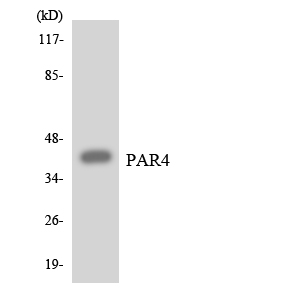PAR-4 Polyclonal Antibody
- Catalog No.:YT3588
- Applications:WB;IF;ELISA
- Reactivity:Human;Mouse;Rat
- Target:
- PAR-4
- Fields:
- >>Rap1 signaling pathway;>>Neuroactive ligand-receptor interaction;>>Complement and coagulation cascades;>>Platelet activation;>>Pathways in cancer
- Gene Name:
- F2RL3
- Protein Name:
- Proteinase-activated receptor 4
- Human Gene Id:
- 9002
- Human Swiss Prot No:
- Q96RI0
- Mouse Gene Id:
- 14065
- Mouse Swiss Prot No:
- O88634
- Rat Gene Id:
- 116498
- Rat Swiss Prot No:
- Q920E0
- Immunogen:
- The antiserum was produced against synthesized peptide derived from human PAR4. AA range:29-78
- Specificity:
- PAR-4 Polyclonal Antibody detects endogenous levels of PAR-4 protein.
- Formulation:
- Liquid in PBS containing 50% glycerol, 0.5% BSA and 0.02% sodium azide.
- Source:
- Polyclonal, Rabbit,IgG
- Dilution:
- WB 1:500 - 1:2000. IF 1:200 - 1:1000. ELISA: 1:10000. Not yet tested in other applications.
- Purification:
- The antibody was affinity-purified from rabbit antiserum by affinity-chromatography using epitope-specific immunogen.
- Concentration:
- 1 mg/ml
- Storage Stability:
- -15°C to -25°C/1 year(Do not lower than -25°C)
- Other Name:
- F2RL3;PAR4;Proteinase-activated receptor 4;PAR-4;Coagulation factor II receptor-like 3;Thrombin receptor-like 3
- Observed Band(KD):
- 41kD
- Background:
- This gene encodes a member of the protease-activated receptor subfamily, part of the G-protein coupled receptor 1 family of proteins. The encoded receptor is proteolytically processed to reveal an extracellular N-terminal tethered ligand that binds to and activates the receptor. This receptor plays a role in blood coagulation, inflammation and response to pain. Hypomethylation at this gene may be associated with lung cancer in human patients. [provided by RefSeq, Sep 2016],
- Function:
- function:Receptor for activated thrombin or trypsin coupled to G proteins that stimulate phosphoinositide hydrolysis. May play a role in platelets activation.,PTM:A proteolytic cleavage generates a new N-terminus that functions as a tethered ligand.,similarity:Belongs to the G-protein coupled receptor 1 family.,tissue specificity:Widely expressed, with highest levels in lung, pancreas, thyroid, testis and small intestine. Not expressed in brain, kidney, spinal cord and peripheral blood leukocytes. Also detected in platelets.,
- Subcellular Location:
- Cell membrane; Multi-pass membrane protein.
- Expression:
- Widely expressed, with highest levels in lung, pancreas, thyroid, testis and small intestine. Not expressed in brain, kidney, spinal cord and peripheral blood leukocytes. Also detected in platelets.
- June 19-2018
- WESTERN IMMUNOBLOTTING PROTOCOL
- June 19-2018
- IMMUNOHISTOCHEMISTRY-PARAFFIN PROTOCOL
- June 19-2018
- IMMUNOFLUORESCENCE PROTOCOL
- September 08-2020
- FLOW-CYTOMEYRT-PROTOCOL
- May 20-2022
- Cell-Based ELISA│解您多样本WB检测之困扰
- July 13-2018
- CELL-BASED-ELISA-PROTOCOL-FOR-ACETYL-PROTEIN
- July 13-2018
- CELL-BASED-ELISA-PROTOCOL-FOR-PHOSPHO-PROTEIN
- July 13-2018
- Antibody-FAQs
- Products Images

- Western Blot analysis of various cells using PAR-4 Polyclonal Antibody

- Immunofluorescence analysis of LOVO cells, using PAR4 Antibody. The picture on the right is blocked with the synthesized peptide.

- Western blot analysis of lysates from HepG2 and Jurkat/HeLa cells, using PAR4 Antibody. The lane on the right is blocked with the synthesized peptide.

- Western blot analysis of the lysates from HT-29 cells using PAR4 antibody.

